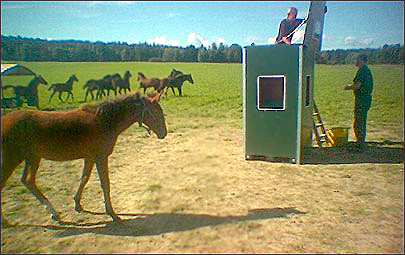Aug 07, 2007Just like a bunch of hungry children grabbing and fighting over food at dinner, horses need help learning their table manners. That's one reason a Swedish company has developed the oat-o-mat, an RFID-based feeder for young studs.
Over the past year, developers at the Radio Frequency Investment Group Sweden (RFIG) have tested prototypes of the RFID horse feeder at the renowned Swedish stud farm Menhammar, on the island of Ekerö. RFIG, a developer and integrator of RFID systems, and Galaxia, its manufacturing partner and a distributor of equipment for horses, will begin marketing the feeder in Europe and the Persian Gulf this fall. The product will be offered in the United States at a later date.
The oat-o-mat offers horse breeders several benefits. It lightens the workload of farmhands, who previously had to portion out servings of feed for each stud at every meal, and it also helps ensure that weaker horses get enough food even if they are pushed away from the feeder by more dominant animals. What's more, breeders have access to electronic data on feeding habits—information veterinarians can use in case a horse is sick or not developing properly. Finally, the system times meals precisely so horses don't get antsy, while also promoting better digestion.
Each horse wears a passive, read-write RFID tag that operates at 125 kHz and is attached to the animal's halter, below the snout. The system's designers opted not to embed a tag under the horse's skin, as that would involve injecting the tag into the animal's neck. An interrogator reads the tag when the horse approaches the feeding carousel, which stands in the middle of a pasture. Some feeder models incorporate a GPRS wireless connection for transmitting data collected via four RFID antennas, which are mounted in the feeder and wired to a single RFID interrogator.
About the size of an outhouse, the square feeder contains four feeding bays on each side, including hatches. Solar panels on an angled roof power the system, which needs enough electricity to operate the PC, the interrogator and antennas—which can read a halter tag as far away as 40 centimeters—and the four motors that raise and drop the hatches on the feeding device.
After the RFID system identifies a horse, the computer prompts the feeder to portion out the proper amount of feed for a given stud, then raises the hatch so the food can slide down a chute to the feeding bay. If one horse shoves another away, the system makes a note that the wrong animal was at the window, and tracks the time it spent there. Horse breeders know roughly how much food a horse consumes per minute. A breeder can add and subtract the amounts of feed each horse received, based on the feeding time calculated by the RFID system.
"The horses have really calmed down," says Lucas Ahlstrom, an RFIG executive. "They learned the feeding system, and their manners improved. They understand that they will get their food. It's a much more sophisticated way of eating."
A few problems arose during the system's development, however. Designers had to put a sheet-metal covering outside the feeding machine to protect it from the horses' gnawing jaws, so the RFID antennas had to be adjusted to avoid interference with the metal. Designers also made later versions of the feeder more stable after observing, in initial tests, that some horses shook it to extract more food after feeding time.
In addition, decreased daylight does not provide enough solar-generated electricity during the fall and winter. To supplement the power, a tractor can be used to charge the equipment's batteries, or a power line can be run from a nearby facility. Custom-designed software controls the feeding system remotely. The data on every horse is stored on the PC and sent to an external database once per day, via a wireless connection and modem.
Sokymat supplies the tags used in the application, with RFID Systems AB providing the interrogators. Antennas come from various manufacturers.
Once commercially available, a large RFID horse feeder with four windows will sell for about $10,000, while a small one with two windows will roughly cost $5,000. According to Ahlstrom, "ROI can be measured in less wasted food, healthier horses and the extra time the owner and staff have due to the automated feeding process."


